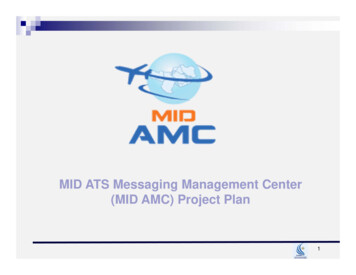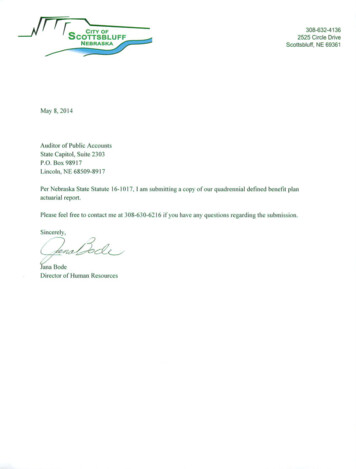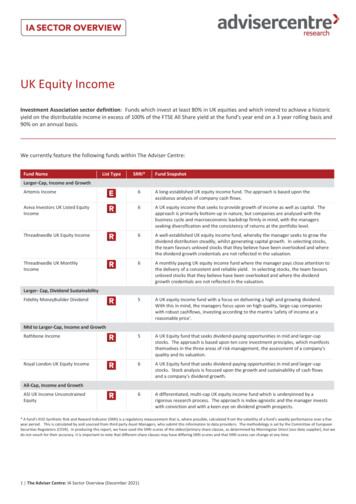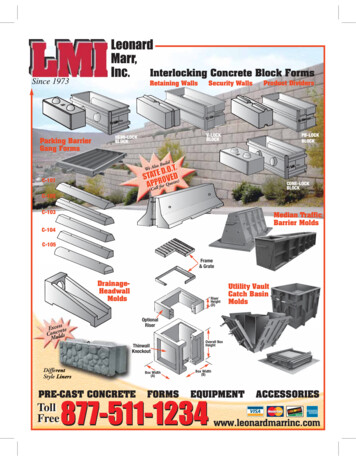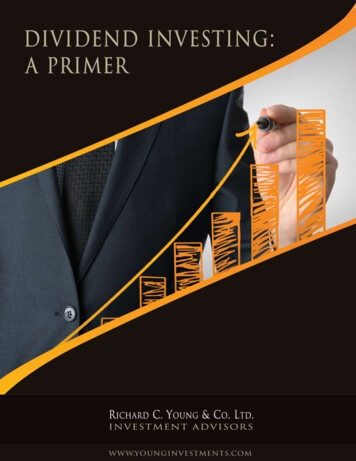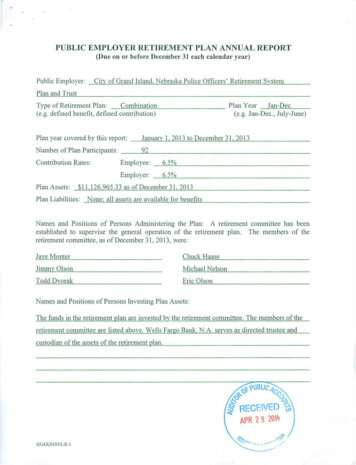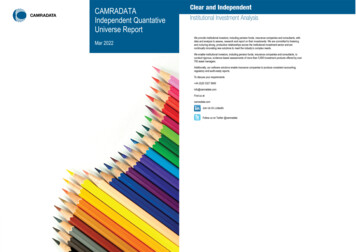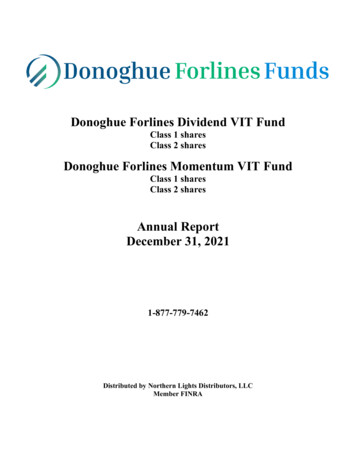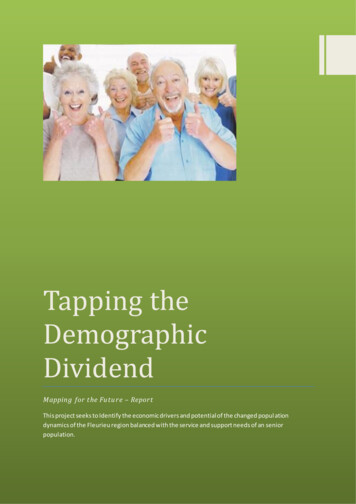
Transcription
DONOGHUE FORLINES DIVIDEND MID-CAP FUNDClassClassClassACIDMCAXDMCCXDMCIX(a series of Northern Lights Fund Trust)Supplement dated February 12, 2021 tothe Prospectus dated October 28, 2020The Board of Trustees of Northern Lights Fund Trust (the “Board”) has determined based on therecommendation of the investment adviser of the Donoghue Forlines Dividend Mid-Cap Fund (the “Fund”),that it is in the best interests of the Fund and its shareholders that the Fund cease operations. The Board hasdetermined to close the Fund and redeem all outstanding shares on March 18, 2021.Effective at the close of business February 12, 2021, the Fund will not accept any purchases and will no longerpursue its stated investment objective. The Fund may begin liquidating its portfolio and may invest in cashequivalents such as money market funds until all shares have been redeemed. Any capital gains will bedistributed as soon as practicable to shareholders. Shares of the Fund are otherwise not available for purchase.Prior to March 18, 2021, you may redeem your shares, including reinvested distributions, in accordance withthe “How to Redeem Shares” section in the Prospectus. Unless your investment in a Fund is through a taxdeferred retirement account, a redemption is subject to tax on any taxable gains. Please refer to the “Tax Status,Dividends and Distributions” section in the Prospectus for general information. You may wish to consult yourtax advisor about your particular situation.ANY SHAREHOLDERS WHO HAVE NOT REDEEMED THEIR SHARES OF THE FUND PRIOR TOMARCH 18, 2021 WILL HAVE THEIR SHARES AUTOMATICALLY REDEEMED AS OF THAT DATE,AND PROCEEDS WILL BE SENT TO THE ADDRESS OF RECORD. IF YOU HAVE QUESTIONS ORNEED ASSISTANCE, PLEASE CONTACT YOUR FINANCIAL ADVISOR DIRECTLY OR THE FUNDSAT 1-877-779-7462.IMPORTANT INFORMATION FOR RETIREMENT PLAN INVESTORSIf you are a retirement plan investor, you should consult your tax advisor regarding the consequences of aredemption of Fund shares. If you receive a distribution from an Individual Retirement Account or a SimplifiedEmployee Pension (SEP) IRA, you must roll the proceeds into another Individual Retirement Account withinsixty (60) days of the date of the distribution in order to avoid having to include the distribution in your taxableincome for the year. If you receive a distribution from a 403(b)(7) Custodian Account (Tax-Sheltered account)or a Keogh Account, you must roll the distribution into a similar type of retirement plan within sixty (60) daysin order to avoid disqualification of your plan and the severe tax consequences that it can bring. If you are thetrustee of a Qualified Retirement Plan, you may reinvest the money in any way permitted by the plan and trustagreement.This Supplement and the existing Prospectus dated October 28, 2020, provide relevant information for all shareholdersand should be retained for future reference. Both the Prospectus and the Statement of Additional Information datedOctober 28, 2020, have been filed with the Securities and Exchange Commission, are incorporated by reference and canbe obtained without charge by calling the Funds at 1-877-779-7462.
Donoghue Forlines Tactical Income FundDonoghue Forlines Dividend FundDonoghue Forlines Momentum FundDonoghue Forlines Tactical Allocation FundDonoghue Forlines Floating Rate FundDonoghue Forlines Dividend Mid-Cap Fund(fka Power Income Fund)Class A: PWRAXClass C: PWRCXClass I: PWRIX(fka Power Momentum Index Fund)Class A: MOJAXClass C: MOJCXClass I: MOJOX(fka Power Floating Rate Index Fund)Class A: FLOAXClass C: FLOCXClass I: FLOTX(fka Power Dividend Index Fund)Class A: PWDAXClass C: PWDCXClass I: PWDIX(fka Power Tactical Allocation/JAForlines Fund)Class A: GTAAXClass C: GLACXClass I: GTAIX(fka Power Dividend Mid-Cap Index Fund)Class A: DMCAXClass C: DMCCXClass I: DMCIXPROSPECTUSOctober 28, 2020Advised byDonoghue Forlines LLCOne International PlaceSuite 310Boston, MA This Prospectus provides important information about the Funds that you should know before investing.Please read it carefully and keep it for future reference.These securities have not been approved or disapproved by the Securities and Exchange Commission norhas the Securities and Exchange Commission passed upon the accuracy or adequacy of this Prospectus.Any representation to the contrary is a criminal offense.Beginning on January 1, 2021, as permitted by regulations adopted by the Securities and ExchangeCommission, paper copies of the Fund’s shareholder reports like this one will no longer be sent by mail,unless you specifically request paper copies of the reports. Instead, the reports will be made available onthe Funds’ website www.donoghueforlinesfunds.com, and you will be notified by mail each time a report isposted and provided with a website link to access the report.You may elect to receive all future reports in paper free of charge. You can inform a Fund that you wish tocontinue receiving paper copies of your shareholder reports calling a Fund at 1-877-779-7462. If you own theseshares through a financial intermediary, contact the financial intermediary to request paper copies. Your electionto receive reports in paper will apply to all funds held with the fund complex or your financial intermediary.If you already elected to receive shareholder reports electronically, you will not be affected by this changeand you need not take any action. You may elect to receive shareholder reports and other communicationsfrom a Fund electronically by contacting your financial intermediary (such as a broker-dealer or bank) or, ifyou are a direct investor, by following the instructions included with paper Fund documents that have beenmailed to you. You may also elect to receive all future reports in paper free of charge.
TABLE OF CONTENTSDONOGHUE FORLINES TACTICAL INCOME FUND – FUND SUMMARY . 1DONOGHUE FORLINES DIVIDEND FUND – FUND SUMMARY. 6DONOGHUE FORLINES MOMENTUM FUND – FUND SUMMARY . 11DONOGHUE FORLINES TACTICAL ALLOCATION FUND – FUND SUMMARY . 16DONOGHUE FORLINES FLOATING RATE FUND – FUND SUMMARY. 22DONOGHUE FORLINES DIVIDEND MID-CAP FUND – FUND SUMMARY . 27ADDITIONAL INFORMATION ABOUTPRINCIPAL INVESTMENT STRATEGIES AND RELATED RISKS . 31Investment Objectives . 31Principal Investment Strategies . 31Principal Investment Risks. 34Temporary Defensive Investments . 39Portfolio Holdings Disclosure . 39Cybersecurity . 39MANAGEMENT . 40Investment Adviser . 40Portfolio Managers . 41HOW SHARES ARE PRICED . 42HOW TO PURCHASE SHARES . 43HOW TO REDEEM SHARES . 46FREQUENT PURCHASES AND REDEMPTIONS OF FUND SHARES . 48TAX STATUS, DIVIDENDS AND DISTRIBUTIONS . 48DISTRIBUTION OF SHARES. 49Distributor. 49Distribution Fees . 49Additional Compensation to Financial Intermediaries . 49Householding . 49FINANCIAL HIGHLIGHTS. 50PRIVACY NOTICE. 68
DONOGHUE FORLINES TACTICAL INCOME FUND – FUND SUMMARYInvestment Objectives: The Donoghue Forlines Tactical Income Fund’s (the “Fund”) primary investment objective is totalreturn from income and capital appreciation with capital preservation as a secondary objective.Fees and Expenses of the Fund: This table describes the fees and expenses that you may pay if you buy and hold sharesof the Fund. You may qualify for sales charge discounts on purchases of Class A shares if you and your family invest, oragree to invest in the future, at least 50,000 in the Fund. More information about these and other discounts is availablefrom your financial professional and in How to Purchase Shares on page 43 of the Fund’s Prospectus.Shareholder Fees(fees paid directly from your investment)Maximum Sales Charge (Load) Imposed on Purchases(as a % of offering price)Maximum Deferred Sales Charge (Load)(as a % of original purchase price)Maximum Sales Charge (Load) Imposed onReinvested Dividends and other DistributionsRedemption Fee(as a % of amount redeemed)Annual Fund Operating Expenses(expenses that you pay each year as apercentage of the value of your investment)Management FeesDistribution and/or Service (12b-1) FeesOther ExpensesAcquired Fund Fees and Expenses(1)Total Annual Fund Operating 62%Acquired Fund Fees and Expenses are the indirect costs of investing in other investment companies. The operating expensesin this fee table will not correlate to the expense ratio in the Fund’s financial highlights because the financial statements includeonly the direct operating expenses incurred by the Fund, not the indirect costs of investing in other investment companies.Example: This Example is intended to help you compare the cost of investing in the Fund with the cost of investing inother mutual funds.The Example assumes that you invest 10,000 in the Fund for the time periods indicated and then redeem all of yourshares at the end of those periods. The Example also assumes that your investment has a 5% return each year andthat the Fund’s operating expenses remain the same. Although your actual costs may be higher or lower, based uponthese assumptions your costs would be:ClassClass AClass CClass I1 Year 680 265 1653 Years 1,058 814 5115 Years 1,460 1,390 88110 Years 2,581 2,954 1,922Portfolio Turnover: The Fund pays transaction costs, such as commissions, when it buys and sells securities (or “turnsover” its portfolio). A higher portfolio turnover may indicate higher transaction costs and may result in higher taxes whenFund shares are held in a taxable account. These costs, which are not reflected in annual fund operating expenses orin the Example, affect the Fund’s performance. During the most recent fiscal year, the Fund’s portfolio turnover was221% of the average value of its portfolio.Principal Investment Strategy: The Fund’s investment adviser seeks to achieve the Fund’s primary investmentobjective by investing in income-producing fixed income and alternative strategy exchange-traded funds (“ETFs”). Theadviser invests Fund assets in ETFs without restriction as to minimum issuer credit quality, sector, capitalization, countryof origin, or security maturity. Fixed income ETFs may invest in non-investment grade fixed income securities, commonlyknown as “high yield” or “junk” bonds that are rated below Baa3 by Moody’s Investors Service or similarly by anotherrating agency. The Fund considers alternative strategy ETFs to be those that invest in commodities, currencies andother alternative assets. The Fund may also invest in ETFs that primarily invest in dividend-paying equity securities ofU.S., foreign and emerging market issuers. The Fund considers emerging market issuers to be those countriesrepresented in the MSCI Emerging Markets Index.1
The adviser seeks to achieve the Fund’s secondary investment objective by reallocating the Fund’s investment portfolio toshort-term maturity fixed income ETFs when it believes fixed income markets will decline. During such periods, the Fundmay invest up to 100% of its assets in such short-term maturity fixed income ETFs. Accordingly, the Fund may not be ableto achieve its primary investment objective of total return during these periods.The adviser tactically allocates the Fund’s assets based on credit research and long-term market trends. In selecting ETFsfor the Fund’s portfolio, the adviser considers an ETF’s underlying holdings, the investment exposure of the ETF and itsliquidity. The adviser may engage in frequent buying and selling of securities to achieve the Fund’s investment objectives,resulting in a higher portfolio turnover.Principal Investment Risks: As with all mutual funds, there is the risk that you could lose money through yourinvestment in the Fund. The Fund is not intended to be a complete investment program. Many factors affect theFund’s net asset value (“NAV”) and performance.The following risks apply to the Fund: Commodities Risk. The Fund may invest in alternative strategy ETFs that invest in the commodities markets maysubject the Fund to greater volatility than investments in traditional securities. Commodity prices may be influencedby unfavorable weather, animal and plant disease, geologic and environmental factors as well as changes ingovernment regulation such as tariffs, embargoes or burdensome production rules and restrictions. Credit Risk. There is a risk that issuers will not make payments on fixed income securities held by the Fund oran ETF in which the Fund invests, resulting in losses to the Fund. In addition, the credit quality of fixed incomesecurities may be lowered if an issuer’s financial condition changes. The issuer of a fixed income security mayalso default on its obligations. Currency Risk. If the Fund invests in ETFs that trade in, and receive revenues in, foreign currencies, it will besubject to the risk that those currencies will decline in value relative to the U.S. dollar, or, in the case of hedgingpositions, that the U.S. dollar will decline in value relative to the currency being hedged. As a result, the Fund’sexposure to foreign currency-denominated securities may reduce the Fund’s returns. Duration Risk. Longer-term securities may be more sensitive to interest rate changes. Given the recent, historicallylow interest rates and the potential for increases in those rates, a heightened risk is posed by rising interest ratesto a fund whose portfolios include longer-term fixed income securities. Duration is the measure of the sensitivity ofa debt security to changes in market interest rates. For example, if interest rates increase by 1%, a fixed incomesecurity with a duration of two years will decrease in value by approximately 2%. Emerging Market Risk. There are typically greater risks involved in investing in emerging markets securities.Generally, economic structures in these countries are less diverse and mature than those in developed countriesand their political systems tend to be less stable. Emerging market economies may be based on only a fewindustries, therefore security issuers, including governments, may be more susceptible to economic weakness andmore likely to default. Emerging market countries also may have relatively unstable governments, weakereconomies, and less-developed legal systems with fewer security holder rights. Investments in emerging marketscountries may be affected by government policies that restrict foreign investment in certain issuers or industries. Equity Risk. The NAV of the Fund will fluctuate based on changes in the value of the equity securities in which itinvests. Equity prices can fall rapidly in response to developments affecting a specific company or industry, or tochanging economic, political or market conditions. ETF and Mutual Fund Risk. ETFs and mutual funds are subject to investment advisory fees and other expenses,which will be indirectly paid by the Fund. As a result, your cost of investing in the Fund will be higher than thecost of investing directly in ETFs and other mutual funds and may be higher than other funds that invest directlyin equity and fixed income securities. Each ETF and mutual fund is subject to specific risks, depending on thenature of the fund. ETF shares may trade at a discount to or a premium above net asset value if there is a limitedmarket in such shares. ETFs and index-tracking mutual funds in which the Fund invests will not be able toreplicate exactly the performance of the indices they track. ETFs are also subject to brokerage and other tradingcosts, which could result in greater expenses to the Fund. Foreign Securities Risk. Foreign investing involves risks not typically associated with U.S. investments,including adverse fluctuations in foreign currency values, adverse political, social and economic developments,less liquidity, greater volatility, less developed or less efficient trading markets, political instability and differingauditing and legal standards. Investing in emerging markets imposes risks different from, or greater than, risksof investing in foreign developed countries.2
Interest Rate Risk. Interest rate risk is the risk that fixed income security prices overall, including the prices ofsecurities held by the Fund or an ETF in which the Fund invests, will decline over short or even long periods oftime due to rising interest rates. Bonds with longer maturities tend to be more sensitive to interest rates thanbonds with shorter maturities. Junk Bond Risk. Lower-quality bonds, known as “high yield” or “junk” bonds, present greater risk than bonds ofhigher quality, including an increased risk of default. An economic downturn or period of rising interest rates couldadversely affect the market for these bonds and reduce the Fund’s ability to sell its bonds. The lack of a liquidmarket for these bonds could decrease the Fund’s share price. Master-Limited Partnership (MLPs) Risk. Investments in MLPs and MLP related securities involve risks differentfrom those of investing in common stock including risks related to limited control and limited rights to vote on mattersaffecting the MLP or MLP-related security, risks related to potential conflicts of interest between an MLP and theMLP’s general partner, cash flow risks, dilution risks and risks related to the general partner’s limited call right.MLPs and MLP-related securities are generally considered interest-rate sensitive investments. During periods ofinterest rate volatility, these investments may not provide attractive returns. Depending on the state of interest ratesin general, the use of MLPs or MLP-related securities could enhance or harm the overall performance of the Fund. Management Risk. The adviser’s judgments about the attractiveness, value and potential appreciation of particularsecurity in which the Fund invests or sells short may prove to be incorrect and may not produce the desired results. Market and Geopolitical Risk. The increasing interconnectivity between global economies and financial marketsincreases the likelihood that events or conditions in one region or financial market may adversely impact issuers ina different country, region or financial market. Securities in the Fund’s portfolio may underperform due to inflation(or expectations for inflation), interest rates, global demand for particular products or resources, natural disasters,pandemics, epidemics, terrorism, regulatory events and governmental or quasi-governmental actions. Theoccurrence of global events similar to those in recent years may result in market volatility and may have long termeffects on both the U.S. and global financial markets. The current novel coronavirus (COVID-19) global pandemicand the aggressive responses taken by many governments, including closing borders, restricting international anddomestic travel, and the imposition of prolonged quarantines or similar restrictions, as well as the forced or voluntaryclosure of, or operational changes to, many retail and other businesses, has had negative impacts, and in manycases severe negative impacts, on markets worldwide. It is not known how long such impacts, or any future impactsof other significant events described above, will or would last, but there could be a prolonged period of globaleconomic slowdown, which may impact your Fund investment. REIT Risk. Investing in real estate investment trusts, or “REITs”, involves certain unique risks in addition to thoseassociated with the real estate sector generally. REITs whose underlying properties are concentrated in a particularindustry or region are also subject to risks affecting such industries and regions. REITs (especially mortgage REITs)are also subject to interest rate risks. By investing in REITs through the Fund, a shareholder will bear expenses ofthe REITs in addition to Fund expenses. Small and Mid-Cap. The value of a small or mid-capitalization company stocks may be subject to more abrupt orerratic market movements than those of larger, more established companies or the market averages in general. Turnover Risk. A higher portfolio turnover will result in higher transactional and brokerage costs. A high portfolioturnover can potentially increase taxes, which can negatively impact Fund performance. Underlying Fund Risk. If short-term treasury exchange traded funds or money market funds (“Underlying Funds”) areutilized, such Underlying Funds are subject to investment advisory and other expenses, which will be indirectly paidby the Fund. As a result, your cost of investing in the Fund will be higher than the cost of investing directly in UnderlyingFunds and may be higher than other mutual funds that do not invest in Underlying Funds. The Fund will only utilizeshort-term treasury exchange-traded funds and money market mutual funds when it is in a defensive position. U.S. Treasury Risk. The Fund has investment exposure to short-term U.S. Treasury securities through itsinvestment in short-term treasury exchange-traded funds. All money market instruments, including U.S. Treasuryobligations, can change in value in response to changes in interest rates, and a major change in rates could causethe share price to change. While U.S. Treasury obligations are backed by the full faith and credit of the U.S.government, an investment in the Fund is neither insured nor guaranteed by the Federal Deposit InsuranceCorporation, U.S. government or any other government agency.3
Performance: The bar chart and performance table below show the variability of the Fund’s returns, which is some indicationof the risks of investing in the Fund. The bar chart shows performance of Class I shares of the Fund for each full calendaryear since the Fund’s inception. Returns for Class A and Class C shares, which are not presented, will vary from the returnsfor Class I shares. The performance table compares the performance of the Fund over time to the performance of abroad-based securities market index and two supplemental indexes. You should be aware that the Fund’s past performance(before and after taxes) may not be an indication of how the Fund will perform in the future. Updated performance informationwill be available at no cost by visiting www.donoghueforlinesfunds.com or by calling 1-877-779-7462.Class I Annual Total Return For Calendar Years Ended December .47%-2.08%2011 2012 2013 2014 2015 2016 2017 2018 2019Best Quarter:Worst Quarter:3/31/20199/30/20114.68%(3.72)%The year-to-date return as of the most recent calendar quarter, which ended September 30, 2020, was (7.05)%.Performance TableAverage Annual Total Returns(For periods ended December 31, 2019)Class I sharesReturn before taxesReturn after taxes on distributionsReturn after taxes on distributions and sale of Fund sharesClass A Return before taxesClass C Return before taxesBloomberg Barclays U.S. Aggregate Bond Index(reflects no deduction for fees, expenses, or taxes)Bloomberg Barclays Global Aggregate Bond IndexReference IndexOne Year9.07%8.38%5.47%3.46%8.02%Five %9.93%2.31%2.43%2.14%2.28%* Class C shares of the Donoghue Forlines Income Fund commenced operations on November 25, 20144
After-tax returns were calculated using the historical highest individual federal marginal income tax rates and do not reflectthe impact of state and local taxes. Actual after-tax returns depend on an investor’s tax situation and may differ from thoseshown, and after-tax returns shown are not relevant to investors who hold shares of the Fund through tax-deferredarrangements, such as 401(k) plans or individual retirement accounts. After tax retusns for Class A and Class C shares,which are not shown, will vary from those of Class I shares.The Bloomberg Barclays U.S. Aggregate Bond Index is a market capitalization-weighted index, meaning the securities inthe index are weighted according to the market size of each bond type. Most U.S. traded investment grade bonds arerepresented. Municipal bonds and Treasury Inflation-Protected Securities are excluded, due to tax treatment issues. Theindex includes Treasury securities, Government agency bonds, mortgage-backed bonds, corporate bonds, and a smallamount of foreign bonds traded in U.S. Unlike a mutual fund, an index does not reflect any trading costs or managementfees. Investors cannot directly invest in an index.The Bloomberg Barclays Global Aggregate Bond Index is composed of the U.S. Aggregate Index, the Pan-European Indexand the Japanese component of the Global Treasury Index. All issues must be fixed rate, nonconvertible and have at leastone year remaining to maturity. Securities from countries classified as emerging markets are excluded. The index isweighted according to each country’s market capitalization, except for Japan, which is weighted by the market capitalizationof the 40 largest Japanese government bonds. This Index has been selected as the Fund’s new primary benchmark as itis more representative of the Fund’s investment strategy and portfolio holdings.The Reference Index is a combination of 80% Bloomberg Barclays Global Aggregate Bond Index, 10% of MSCI ACWI, and10% of S&P Goldman Sachs Commodities Index. The MSCI ACWI Index represents the performance of the full opportunityset of large- and mid-cap stocks across 23 developed and 26 emerging markets. The S&P Goldman Sachs CommoditiesIndex is a composite index of commodity sector returns representing an unleveraged, long-only investment in commodityfutures that is broadly diversified across the spectrum of commodities.Investment Adviser: Donoghue Forlines LLC is the Fund’s investment adviser.Portfolio Managers: John A. Forlines, CIO of the adviser, Jeffrey R. Thompson, CEO of the adviser, Richard E. Molari,COO of the adviser and Nicholas A. Lobley, Portfolio Manager of the adviser each serve the Fund as a PortfolioCo-Manager. Mr. Thompson hasserved the Fund as a Portfolio Co-Manager since it commenced operations in 2010.Mr. Molari has served the Fund as a Portfolio Co-Manager since October 2016. Mr. Forlines has served the Fund asPortfolio Co-Manager since October 2018. Mr. Lobley served the Fund as Portfolio Co-Manager since December 2019.Each portfolio manager is jointly and primarily responsible for the day-to-day management of the Fund.Purchase and Sale of Fund Shares: You may purchase and redeem shares of the Fund on any day that the New YorkStock Exchange is open for trading by written request, telephone or website. The minimum initial and subsequentinvestment for Class A shares is 1,000 and 100, respectively. The minimum initial investment for Class I shares is 100,000. There is no minimum subsequent investment for Class I shares.Tax Information: Dividends and capital gain distributions you receive from the Fund, whether you reinvest yourdistributions in additional Fund shares or receive them in cash, are taxable to you at either ordinary income or capital gainstax rates unless you are investing through a tax-deferred plan such as an IRA or 401(k) plan. However, these dividend andcapital gain distributions may be taxable upon their eventual withdrawa
DONOGHUE FORLINES DIVIDEND MID-CAP FUND Class A DMCAX Class C DMCCX Class I DMCIX (a series of Northern Lights Fund Trust) Supplement dated February 12, 2021 to the Prospectus dated October 28, 2020 The Board of Trustees of Northern Lights Fund Trust (the "Board") has determined based on the
